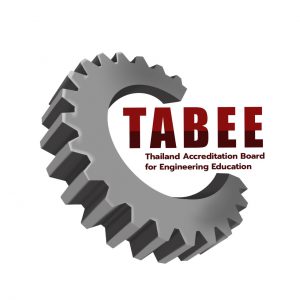
Accreditation Criteria
Accreditation Criteria for the 2019 – 2024 Review Cycle
On May, 2019, the TABEE Committee approved a revised Accreditation Criteria, Policy and Procedure Manual for implementation in the 2019 – 2024 accreditation cycle. The revised Accreditation Criteria has been posted for the 2019 – 2024 accreditation cycle.
<2019 – 2024 Accreditation Criteria, Policy and Procedure Manual>
Crierion 1 Students
Quality and professional competence of program graduates are essential components of program outcomes evaluation. An educational program seeking for accreditation is required to have process for assessment of student learning outcomes with adequate student advisory on activities towards his/her profession career development. The program must have formative and summative assessments and program monitoring throughout the education period to ensure that they have attained both quality and attributes set forth in the curriculum objectives.
An educational program seeking for accreditation must have program control procedures and admission statement for selecting student enrollment or admission of student to the program, the transfer of educational credits from other institutes to the program, and work procedures for program teaching and learning to ensure that the students are able to graduate from the program with the quality and attributes as prescribed by the program.
Criterion 2 Program Educational Objectives
An educational program seeking for accreditation of engineering education must have a program statement describing the program objectives, of which indicates that graduate of the program should attain expected program outcomes for engineering professional practice in the program discipline.
An educational program seeking for accreditation of engineering program must have the following components;
1. Curriculum objectives that have been published and distributed. The curriculum objectives and contents must be corresponding to institutional mission and complying with TABEE criteria.
2. Process to establish the curriculum objectives which are corresponding to result of assessment and periodical review of the curriculum. The curriculum objectives set forth by the program should serve societal demand for engineering profession career development from all constituents beneficiary of program outcomes.
3. Curriculum, program teaching and learning, and program management that serve to achieve the set forth curriculum objectives and the program outcomes.
4. Program outcomes assessment and evaluation process that have been used for reviewing and improvement of curriculum for program students to benefit from quality education.
Criterion 3 Program Outcomes
This program outcome used as accreditation criteria is a statement indicating that the program graduates are expected to attain knowledge, professional skills and behavioral attributes as they are required in engineering field of professional practice.
The educational program must submit evidence to TABEE; showing linkage between curriculum objectives and program outcomes.
Program outcomes as they are indicated by attributes of program graduates are as following;
1. Knowledge of Mathematics, Science and Engineering
Ability to apply knowledge of mathematics, natural science, engineering fundamentals and a specific engineering to conceptualize the engineering models, definitions, and/or to respectively apply methodologies, processes, and/or engineering systems in the work place.
2. Engineering Problems Analysis
Ability to identify, formulate, research literature review, solve, and analyze complex engineering problems reaching substantiated conclusions using principles of mathematics, natural sciences and engineering sciences.
3. Design and Development Solutions for Complex Engineering
Ability to design and find solutions for complex engineering problems and design systems, components or processes that meet specified needs with appropriate consideration for public health and safety, cultural, societal, environmental considerations, and/or professional code of practices.
4. Investigation
Ability to conduct investigations, diagnosis, and evaluation of complex problems using research-based knowledge and research methods including design of experiments, analysis and interpretation of data, and synthesis of information to provide valid conclusions.
5. Modern Tool Usage
Ability to create, select and apply appropriate techniques, resources, and modern engineering and IT tools, including prediction and modelling, to complex engineering problems, with an understanding of the limitations.
6. Individual and Team Work Function effectively as an individual, and as a member or leader in diverse teams and in multi-disciplinary settings.
7. Communication
Communicate effectively with the engineering community and with society at large, such as being able to comprehend and write effective reports and design documentation, make effective presentations, and give and receive clear instructions.
8. Society, Environment, Sustainability, and Engineering Profession
Understand and responsible for engineering professional practice to societal and environmental contexts and evaluate the sustainability and impact of professional engineering work in the solution of complex engineering problems in societal and environmental contexts.
9. Ethics
Apply ethical principles and commit to professional ethics and responsibilities and norms of engineering practice.
10. Project Management and Finance
Demonstrate knowledge and understanding of the principles of economic, and engineering management under consideration of risk and uncertainties.
11. Lifelong Learning
Recognize the need for, and have the preparation and ability to engage in independent and life-long learning.
Criterion 4 Continuous Improvement
The program must regularly use appropriate, documented processes for monitoring, assessing and evaluating program outcomes that students and graduates of the program are attained.
The results of these evaluations must be systematically utilized as input for the continuous improvement of the program.
Criterion 5 Curriculum
The curriculum must appropriately specify areas of knowledge contents to serve program educational objectives and required program outcomes for each field of professional practice.
The program curriculum structure must include following areas of knowledge contents.
1. College level mathematics and basics sciences (including experimental experiences) appropriately to the program discipline, with combined educational work load of not less than 30 credits in semester system or equivalent to educational load of one academic year.
2. Basic engineering and specific engineering topics (including experimental experiences) appropriately to the program discipline to provide a bridge between mathematics and basic sciences, and basic engineering for student to appropriately use in engineering design and solving of complex engineering problems according to engineering work requirements, with combined educational work load of not less than 45 credits in semester system or equivalent to educational load of one and a half academic years.
3. General education that complements the technical contents of the curriculum and is consistent with program educational objectives and institutional objectives.
The program curriculum must provide engineering practice and engineering projects that allow students to have engineering design experiences and solving complex engineering in the final year of education which allow students to use the knowledge and skills acquired in earlier course work and incorporating appropriate engineering standards and multiple realistic constraints.
Criterion 6 Faculty
Educational institute must provide adequate number of faculty. The faculty must have the educational qualification with professional competence relevance to the program discipline. The faculty must also provide adequate student advisory relating to students’ professional career development and other activities related with professional society and industry.
The program teaching staff must demonstrate, both academic and professional competence, regarding student advisory and student career development including teaching and student evaluation for the continuous quality improvement of teaching to achieve learning outcomes as prescribed in curriculum objectives.
Criterion 7 Facilities
The educational program must provide continuously support to the program with adequate facilities, including classrooms, laboratories, library, and other supporting infrastructure to accommodate academic environment, academic development, professional activities of student, as well as quality education. The program must continuously stimulate student learning opportunities by provision of modern tools and equipment, information technology and communication network for student and academic staff to serve requirements for academic development and extra-curriculum activities in accordance with curriculum educational objectives.
Criterion 8 Institutional Support
Institutional support and program leadership must be adequate to ensure the quality and continuity of the program. Institutional financial support provided to the program must be adequate to meet program needs. Resources available to the program must be sufficient to promote, retain, and provide for the continued professional development of a qualified faculty. Resources must be sufficient to acquire, maintain, and operate infrastructures, facilities and equipment appropriate for the program, so that program outcomes can be attained. In addition, the educational institution must provide adequate supporting staff and educational services for program teaching and learning and program management.

